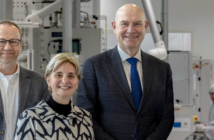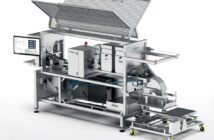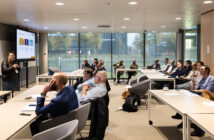The fact that the high-tech ecosystem in the Brainport region is an extremely powerful engine of the country’s economy and welfare is beyond dispute. It’s great that the government has at long last attached the ‘mainport’ label to it. But what makes this ecosystem unique? And what are the strengths, threats and opportunities for preserving or even enhancing that position of global strength? That was the subject of the round table set up by Link Magazine in Nuenen on 15 March. Putting the ‘miracle of Eindhoven’ into perspective.
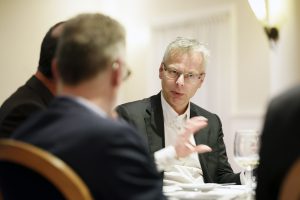
Gerrit van der Beek (Liteq): ‘It is crucial to have firms which are outstanding in a specific discipline.’ Photo Bart Overbeeke
‘There is a real mobilising force here to get things done’
There was a mixed company sat around the table at Collse Hoeve. Moderator Jan Mengelers, chair of the executive board of Eindhoven University of Technology, was representing the research institutes, while Joep Brouwers (a member of the Brainport Development management board) was there on behalf of an intermediary organisation. The OEMs were represented by Bas Hulsken (head of technology Philips Digital Pathology Solutions), Vincent Kwaks (CTO Vanderlande Industries) and Gerrit van der Beek (CEO of start-up Liteq). And Frank Mulders, CEO of AAE/Grauel, provided some useful input as a systems supplier.
Moderator Jan Mengelers opens with the soft skills which he believes set Brabant apart: a dash of conviviality, an open attitude and a willingness to work together. These things are important, agrees Gerrit van der Beek: ‘Coming together, having a laugh; the culture here connects people, in business too.’ Joep Brouwers adds: ‘In highly complex manufacturing industry, you do nothing alone. Whatever you make, you make with a whole lot of others. Things work well if you deal with each other in a businesslike and non-hierarchical manner; it helps things go smoothly.’
Frank Mulders points to a harder fact, one which he believes is unique: ‘The entire chain of OEMs, suppliers and research and educational institute is present here. It is a wonderfully rounded and large ecosystem, in which all the players come across one another – in the manufacturing forums in Eindhoven (EFK) and Helmond (VICH), Brainport Industries, the Brabant-Zeeland Employers’ Association and other networks. And because we all operate globally, we understand and value each other. For example, when I visit ASML, outwardly I feel AAE but inwardly I feel ASML. I appreciate how smart what they do is and what we do together. In this region, we are so connected that we are proud of each other.’
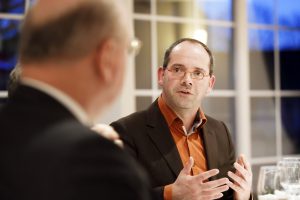
Bas Hulsken (Philips Digital Pathology Solutions): ‘Foreign visitors are amazed when they see the quality of suppliers like Prodrive, Frencken and Sioux CCM.’ Photo Bart Overbeeke
The same competences
‘The supply chain is in order here’, notes Bas Hulsken. ‘We think of Brainport as ‘Optical Valley’, with world-class competences in imaging. Our scanners make really big images at very high resolution, the opposite of what ASML do. But it calls for the same competences. The control systems for nanometre-precise positioning, high-speed data processing, the know-how required to make good optics; all of this is very well represented in this region. I travel all over the world, but I have only really seen that here. Foreign visitors are amazed when they see the quality of suppliers like Prodrive, Frencken and Sioux CCM.’
The region is very important for Vanderlande Industries too, says Victor Kwaks. ‘Philips has a proud engineering culture here and has created a sense of technology-driven entrepreneurship and togetherness: we are at the top of the league table in the Netherlands in terms of employee satisfaction. These founding aspects of the ecosystem are in this region’s DNA.’
Genuinely distinctive
Core competencies which are a legacy of the past, such as mechanics, optics and accurate positioning, Van der Beek describes as ‘a kind of nucleus for new competences and products’. ‘In particular software competences, which are becoming ever more important – for embedded systems and ultimately also for new applications; they keep the ecosystem thriving. Mengeler adds: ‘All the muscle groups for acting at a global level are well-developed. ASML makes the most difficult machine in the world, thanks to the superb mechatronics and software competences which have been developed here.’
This is what sets Brainport apart, Brouwers remarks. ‘The province of Zuid-Holland has more high-tech firms than we do in numerical terms. But they don’t have that complex ecosystem with very large players centred on a number of core competencies. With all due respect to Twente (the industrial region in the eastern Netherlands, ed.), which is itself a very attractive region, the high-tech key players there feel more connected with the ecosystem here. It is key to their development.’
A kind of mobilising force
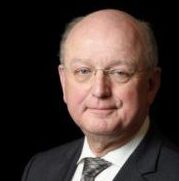
Jan Mengelers (TU/e): ‘The 50 leading decision-makers in the triangle know each other and have each other’s mobile numbers.’ Photo Bart Overbeeke
Jan Mengelers takes a step back: ‘Elsewhere in the Netherlands, I have also encountered very pleasant individuals who are good at bringing people together. And you also find that golden triangle there, made up of research institutes, companies and their supply chains and government. So why doesn’t what works here work there? My observation is that two of the three sides are often present, but rarely are all three connected. In Rotterdam, the city and the port don’t talk to one another. Here, all three sides of the triangle are constantly mingling, on all kinds of occasions. The 50 top people within that triangle know each other and have each other’s mobile numbers. There is a kind of mobilising force here to get things done. That culture of knowing each other, coming together, working together and goodwill is part of the usefulness principle; an unprecedented strength which I have not seen elsewhere.’
Global supply chain
Gerrit van der Beek identifies a danger: ‘Many companies started off in a specific discipline – electronics, mechanics, software – and are shifting towards becoming system suppliers. They are all becoming rather alike, whereas I believe it is crucial to have companies which are outstanding in a specific discipline.’ Frank Mulders recognises the danger; he believes the prospects are better for complementary collaborations between parties together performing the role of systems supplier. ‘That is a far more effective method than doing everything yourself and all becoming applications managers. Let’s not all start competing with one another but instead develop that collaboration further.’
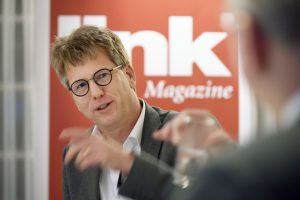
Vincent Kwaks (Vanderlande Industries): ‘People are being trained for jobs they are not going to get – because those jobs will have changed even while they are at university.’ Photo Bart Overbeeke
Vincent Kwaks observes that Vanderlande’s ecosystem is largely located outside the Netherlands. ‘But looking at what we have developed over the past five years, our supply chain has become far more international. Not all the competences we need are present in this region. Robotics, for example, you definitely won’t find in Eindhoven.’ Which is not to say that Vanderlande is gradually turning its back on the Brainport ecosystem. ‘I think that 70 percent of our engineers come from the University of Technology, so that connection is part of our fabric.’
His advice: decide which competences are essential and invest only in those. ‘The restrictions on government support for research institutes has enormously diluted knowledge development and research. Given that scenario, it is a crying shame to do the same thing in two places at once. A single university of technology (with three sites, ed.), as advocated by ASML’s Peter Wennink, is a good idea.’ Mengelers adds: ‘We need to think carefully about which competences we need if we are to still be developing and building world-class things here in this region in 2030.’
New incubator
Joep Brouwers cites the heritage of Philips as an ‘enormous incubator’. ‘If photonics had been a promising, upcoming technology 20 or 30 years ago instead of now, people at Philips would have been given the money and space to work out what to do with it. Philips might have spun off a firm which would immediately have had a position in that new market; look at the story of ASML. We need to rediscover that incubator role in the ecosystem, otherwise we will have a serious problem.’
As yet, there is no tailor-made answer to how that should be or can be done, says Brouwers. ‘Much of what the OEMs and research institutes discover and develop never gets used, it’s lying in a drawer somewhere. The challenge is how we can get a handle on that within our ecosystem. There is a lot to be gained by doing so. Besides that, we need to find a way to re-engage with what Philips succeeded in back then, with its deep pockets and golden touch at getting stuff onto the market. For example, by forming an alliance of OEMs, top suppliers and research institutes, with public support.’
High-risk, high reward
The fact that the pool of high-tech OEMs in the region needs to be expanded is something everyone agrees on. Van der Beek points to the importance of good support for start-ups – and sees a gap there. ‘It is almost impossible to find the money to turn a great innovation into a successful company. Investors are really looking for software-like, app-like innovations they can cash in within one or two years. As a result, brilliant high-risk, high-reward innovations are dying a death, or being picked up by foreign players. Which means those innovations are lost to the Netherlands.’ According to Mengelers, the government needs to adopt a position on this. ‘But which of the political parties is still talking about support for innovation? Not one. Getting politicians on board is a hard sell. In Singapore, it’s a very different story: there they are putting €3 billion into a new national programme over 10 years – they are going for it.’
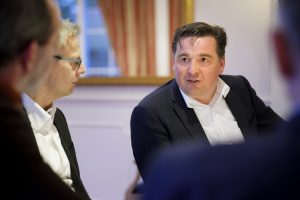
Frank Mulders (AAE/Grauel): ‘In this region, we are so connected that we are proud of each other.’ Photo Bart Overbeeke
Insufficient ambition
Mulders observes that start-ups are not seen as sufficiently cool and sexy in the Netherlands. ‘Promising start-ups deserve to be valued more in my opinion.’ Van der Beek adds: ‘In the States, if you have a couple of failed start-ups behind you, you are a hero. Here, you have a black mark against your name.’ Kwaks says he talks to companies who are happy to put a lot of money – ‘up to 50 million’ – into a start-up. ‘As long as they believe in it.’ He cites the ‘Make Next’ platform set up by ASML, Huisman and Vanderlande as a breeding ground for new OEMs. ‘Within that platform, we help scale-ups with knowledge and expertise in technological, organisational, strategic issues, IP matters, etc. A firm like Smart Photonics was happy to receive that kind of help, but a lot of others say: ‘Leave it, we’re fine as we are’. Many potential scale-ups in the Netherlands lack the ambition to move on up to the next phase; they simply aren’t interested’.
High degree of alignment
Bas Hulsken returns to Brainport’s strengths. ‘We (Philips Digital Pathology Solutions, ed.) are growing enormously, we are doubling the headcount of our development organisation pretty much every year. We consider ourselves lucky that there is so much technical talent in this region. Moreover, in a sense that talent is self-nurturing: engineers from the various companies meet socially and share knowledge and competences informally. That way, the incubator role we were talking about is distributed across multiple companies. My advice would be: put a lot of effort into enthusing, growing and holding onto top talent.’
Jan Mengelers endorses that. ‘The Brainport National Agenda (see page 4, ed.) which is on the way will emphasise the retention and further development of talent and expertise. There is a lot to be gained that way, and we need to communicate our successes in this area more explicitly, including abroad. Students are able to follow high-quality, English-language study programmes at the University of Technology. After which, because the connection with high-tech industry is already there, they walk straight into brilliant jobs within the ecosystem – perhaps not with the big salaries sometimes paid elsewhere in the world, but with a good all-round package which the current generation really values.’
‘Continuous change’, says Vincent Kwaks, ‘is a must. Stand still for a moment and you’re finished. We have a permanent focus on changing our organisation so that it can handle change, so that it is adaptive. There is also a role for educational institutes here. The thing is, people are being trained for jobs they are not going to get – because those job will have changed even during the time they are at university.’
Article Southern Netherlands issue Link magazine 2017
THEMA High performance in high precision


